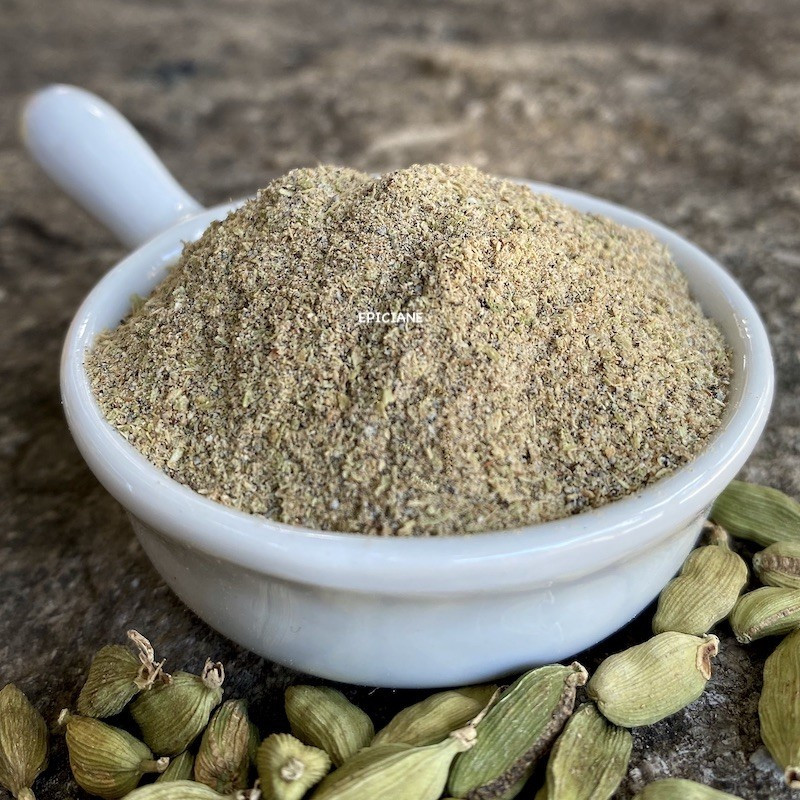
Reference: 10M6821604


Its fragrance is extraordinary and powerful, somewhere between licorice and eucalyptus, with a more lemony note.
It works wonders in flavoring gingerbread, Indian curries, rice, and many other dishes. However, for alcoholic beverages, tea, coffee, and other liquids, it’s better to use whole seeds.
 Delivery
Delivery
Mondial Relay
 Returns
Returns
See conditions
 Payments
Payments
100% secure
Livré en sachet refermable
Uses in Cooking:
Equally suited for both sweet and savory dishes, green cardamom has an extraordinarily powerful fragrance, somewhat reminiscent of eucalyptus but more lemony. Surprisingly, despite its strong flavor, it has the unique ability to enhance other flavors, especially in spice blends. It complements a wide variety of dishes and is often found in spice mixtures. You can easily incorporate it into your cooking.
It is widely used in Indian cuisine, in tea, coffee (preferably whole or in seeds in these cases), rice, curries, and also in Asian and African (notably Ethiopian) cooking. Cardamom also flavors ice creams and is frequently part of gingerbread spice mixes.
In Turkey, the custom is to add a pod to each cup of coffee. In Europe, cardamom is used in Scandinavian cuisine (aquavit, bread).
In India, it’s common to chew a few pods after meals, aiding digestion and leaving the breath fresh (it’s especially effective at neutralizing raw garlic odor!).
When used whole, cardamom is one of the few spices that can be placed in rice cooking water, infusing the grains deeply.
In small amounts, cardamom pairs with almost any dish: jams, ice creams, meat sauces, meat terrines, white pudding.
Who am I?
Origin: Guatemala
Scientific name: Elettaria cardamomum
Cardamom is a rhizome-bearing herbaceous plant from the Zingiberaceae family (like ginger and turmeric), originally from the Malabar Coast, which also produces pepper. It was domesticated in southern India and prefers warm, humid climates.
In Europe, cardamom made its appearance in the Middle Ages, when it was used in hypocras, a spiced wine served as an aperitif.
Cardamom is an expensive spice because its harvest is challenging, with seeds developing close to the ground. The dried fruit is used, appearing as almond-green capsules about 1 cm long, containing three compartments filled with dark brown seeds that hold most of the fragrance. As the fruit dries, it turns straw-colored. It’s also sold as bleached capsules, usually sun-bleached, but more often artificially treated with chlorine, which is less appealing!
Even the plant’s leaves carry the characteristic scent when crushed!
A Little History:
The name is probably of Indian origin, passed down through the Arabs.
Data sheet
Specific References
Reference: 10M6821604
Reference: cardamomeverteE
Reference: paindepices
Reference: 408164502
Reference: 10M6741201
Reference: coriandreE
Reference: 10N7726601
Reference: 9N7655101
Reference: 11N7866301
Reference: 29923901
Reference: 11N78924G1
Reference: B392185-5
Reference: 4N7314501
Reference: 12N7952502
Reference: 20721302
Reference: 00234301
Reference: cardamomeverteE

Its fragrance is extraordinary and powerful, somewhere between licorice and eucalyptus, with a more lemony note.
It works wonders in flavoring gingerbread, Indian curries, rice, and many other dishes. However, for alcoholic beverages, tea, coffee, and other liquids, it’s better to use whole seeds.